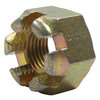In preparing for my mechanic to do the annual on my 182 and as a generally good idea I have tried to purchase an assortment of hardware that may need to be replaced so that all the parts are on hand. I have 1962 182E and I have the parts manual which I have been using to determine the correct parts.
my question is with what many mechanics are saying and some of what I read online about when you should use a drilled bolt, castle nut and cotter pin vs using a nylon lock nut on an in drilled bolt. It seems that rotating pints should have a cotter pin which makes sense but a property torqued rod end bearing should not rotate.
More specifically, the service manual for my plane shows AN3-7a & MS21044N3 hardware to be used to connect the rod ends at the aileron bell crank and the control bracket. That listed hardware is not drilled and uses a nylon lock nut.
since it is in the service manual I assume that it was correct at least in 1962 but it is still the correct way to do it?
thx.
my question is with what many mechanics are saying and some of what I read online about when you should use a drilled bolt, castle nut and cotter pin vs using a nylon lock nut on an in drilled bolt. It seems that rotating pints should have a cotter pin which makes sense but a property torqued rod end bearing should not rotate.
More specifically, the service manual for my plane shows AN3-7a & MS21044N3 hardware to be used to connect the rod ends at the aileron bell crank and the control bracket. That listed hardware is not drilled and uses a nylon lock nut.
since it is in the service manual I assume that it was correct at least in 1962 but it is still the correct way to do it?
thx.

 Torque putty maybe called for when nylon lock nuts are specified with a visual inspection interval like annual or 100hr.
Torque putty maybe called for when nylon lock nuts are specified with a visual inspection interval like annual or 100hr.

